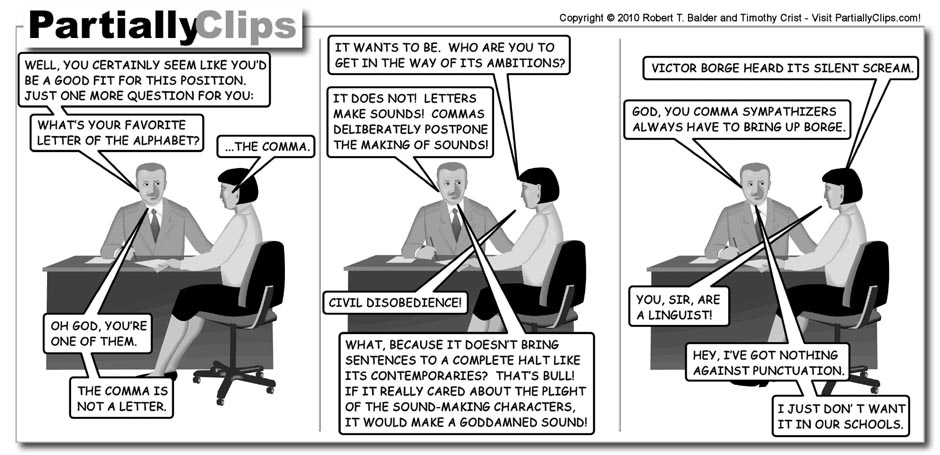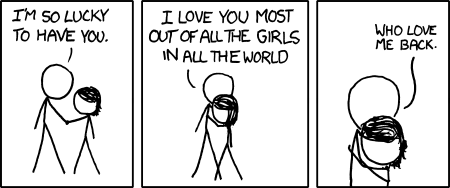Archive for Linguistics in the comics
Irreproducible results
This morning's Non Sequitur is not, as far as I know, a comment on my previous post:
Read the rest of this entry »
Placebo questions
The phrase placebo questions comes up in today's Dilbert strip. You can see the intended meaning (once you realize that Dilbert's boss has handed him a project so confidential that a lot depends on his keeping it rigorously secret), despite the stretch from the medical use that nearly everyone is familiar with. It's an unusual word, placebo: it comes directly from an inflected word of another language. It is the first person singular future form of the verb placere in Latin: it means "I will please". It apparently entered common parlance on the strength of being the first word of the first antiphon in the Latin text of the Catholic service of vespers for the dead, and somehow got picked as the technical term for an inactive substance used as a control in testing pharmaceutical products.
Read the rest of this entry »
"You, sir, are a linguist."
The Logogeneplex
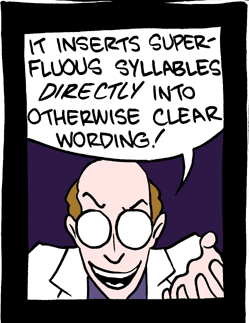 Zach Weiner's most recent Saturday Morning Breakfast Cereal reveals an invention that may allow Big Science to complete the transition to assembly-line methods.
Zach Weiner's most recent Saturday Morning Breakfast Cereal reveals an invention that may allow Big Science to complete the transition to assembly-line methods.
But for me, this strip raised an iconographic question: when did white lab coats become the comic-strip uniform of scientists? And when this convention arose, which scientists actually wore white lab coats? Because these days, it's not easy to find an actual scientist (as opposed to one in a comic or an advertisement) who wears (or even owns) one. [OK, I yield to the commenters who observe e.g. that "in … biomedical research, maybe a third of the researchers wear lab coats whenever they're at the bench". Let's just say that a fairly small minority of scientists (and engineers and other inventors) wear white lab coats, and leave it at that.]
Read the rest of this entry »
Scientific reasoning across the multiverse
With a hat tip to Bruce Webster, more cartoons for the weekend, this time from Jonathan Rosenberg's Scenes from a Multiverse:
Read the rest of this entry »
It's scholarin' time!
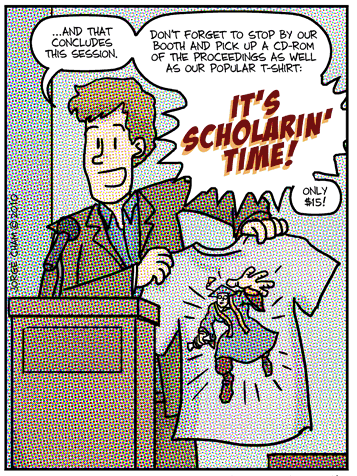 The most recent PhD Comics strip by Jorge Cham features real-life material from the scholarly side of the 2010 Comic Arts Conference, and especially the work of Neil Cohn, a psychology grad student at Tufts who "measures people's brain waves while they read comics".
The most recent PhD Comics strip by Jorge Cham features real-life material from the scholarly side of the 2010 Comic Arts Conference, and especially the work of Neil Cohn, a psychology grad student at Tufts who "measures people's brain waves while they read comics".
You can read Neil's own account of his presentation on his blog, The Visual Linguist:
My talk seemed to go fairly well (thanks to those who came!), and I greatly enjoyed the discussions with people afterwards. This was the first year I got to present actually experimental brain data on comics, which I'd been looking forward to for awhile.
You can also check out Neil's Visual Language Research Bibliography (which doesn't seem to include any of his neuroscience work yet), or read a PR profile from the "Tufts Office of Web Communication". I also note that the web site for Tufts' Center For Cognitive Studies supplements the usual lists of affiliated faculty, courses, publications, etc., with a list of relevant Zippy cartoons, which may be a symptom of the factors that led Neil to pursue his studies there.
Read the rest of this entry »
More on the early days of obscenicons
Last week I posted about the early history of cartoon cursing characters, aka grawlixes, aka obscenicons. I had managed to unearth examples of obscenicons on comics pages going back to 1909, from Rudolph Dirks' "The Katzenjammer Kids." I've had a chance to do some more digging, and I've found that Dirks was getting creative with obscenicons as early as 1902 — and he wasn't the only cartoonist indulging in them.
Read the rest of this entry »
Obscenicons a century ago
Mark Liberman recently asked, "What was the earliest use of mixed typographical symbols (as opposed to uniform asterisks or underlining) to represent (part or all of) taboo words?" The use of such symbols appears to have originated as a comic-strip convention. Comic strip fans, following Mort Walker's Lexicon of Comicana, have often called these cursing characters grawlixes, though I prefer the term obscenicons. In Gwillim Law's history of grawlixes, he lists examples of cartoon cursing going back to the Sep. 3, 1911 installment of "The Katzenjammer Kids." Here is the panel in question (which I found in the Washington Post archives):
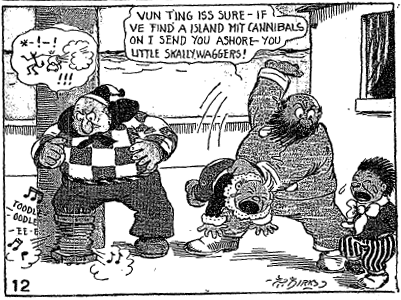
Along with a sequence of asterisk-dash-exclamation point-dash-exclamation point, the speech balloon also features what appears to be a stick-figure devil firing a cannon, with three more exclamation points for good measure. As delightful as this example is, it's not the earliest use of obscenicons on the comics page. I found another "Katzenjammer Kids" strip using them, from two years earlier.
Read the rest of this entry »
Inscriptional theory of mind, again
Yesterday, commenting on "Theory of mind in the comics", tablogloid wrote:
I was raised in a very strict Catholic family in the 1950s. I also read a lot of comic books. As a result, every Sunday as I sat through Mass, I was so sure that the priest could read my thought captions that I used to brush my hand over the top of my head to try and pop the bubble and erase the copy.
This morning's Tank McNamara strip illustrates the effect:
Read the rest of this entry »
Theory of mind in the comics
Tank McNamara has been exploring the psychological implications of thought balloons. Here's yesterday's strip, which illustrates the point that despite the crucial role of "theory of mind" in human evolution and child development, the ability to attribute beliefs, knowledge and emotions to others is not always a good thing.
(As usual, click to embiggen.)
Read the rest of this entry »


